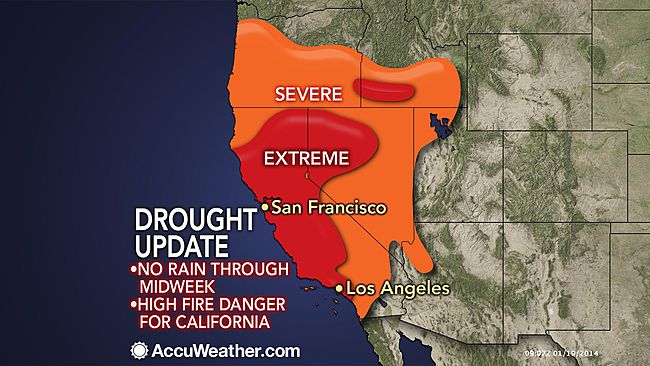
Extreme dry spell threatens food supply, shows need for spending on public works.
It never rains in California,” Albert Hammond sang in the chorus of his 1972 hit single. In recent winters, it doesn’t snow much, either. And that’s a big problem, not just for the Golden State but for the whole nation.
California is in the third year of one of its worst droughts of the past century. According to the U.S. Drought Monitor, 82% of the state is in extreme or exceptional drought, up from 28% at the beginning of the year.
Beyond the obvious risks of wildfires and crop losses, this drought carries lessons about the need for states and localities to prepare for extreme weather and to invest in water resources, just as they need to spend money on roads, bridges, airports and other basic public works.
Such investment is lagging. In a report card last year, the American Society of Civil Engineers gave the nation a “D” in drinking water infrastructure. Los Angeles’ underinvestment in its aging water pipes was underscored by the spectacular rupture of a 90-year-old valve on Sunset Boulevard in July, which spilled 20 million gallons of precious water.
To see the benefits of farsighted investment, look no further than the $12 billion that Southern California agencies have poured into reservoirs and other improvements since the last big multiyear drought, from 1987 to 1992. Without that spending, the situation would be far more dire. As Pacific Institute President Peter Gleick wrote in July, “Water still comes out of my tap, in unrestricted amounts and superb quality, at a reasonable price.”
In the Central Valley — where as much as half the country’s fruits and vegetables are grown — the drought’s effect has been more severe but relatively modest. This year’s agriculture revenue losses are estimated at $1 billion, in a $45 billion industry, with a loss of about 17,100 seasonal and part-time farm jobs.
One reason the impact hasn’t been greater is that as surface water dries up, Californians have been pumping more groundwater. That’s a problem because underground aquifers are being tapped at unsustainable rates. Lester Snow, executive director of the non-profit California Water Foundation, likens the situation to a savings account from which everyone makes withdrawals and no one makes deposits.
Going forward, the scary part is that no one knows whether this drought will end soon or will last for many years. Hopes are fading for a drought-busting El Niño weather pattern this winter.
One big wild card is climate change. Semi-arid Southern California has always been drought prone, but many scientists suspect that global warming is exacerbating the current dry spell. Indeed, the first half of 2014 was by far the hottest in California in 120 years of record-keeping.
A megadrought would produce more wildfires, bitter competition between urban and agricultural interests, and higher prices for produce and nuts across the USA. That makes the appropriate response an “all of the above” approach that includes improving groundwater management, cleaning up contaminated aquifers, raising prices for heavy water users and increasing conservation, storage and recycling. Passage of a $7 billion water bond on the November ballot in California would be an important step.
And what about all that Pacific Ocean saltwater along the state’s 840-mile coastline?
A $700 million desalination plant being built in Carlsbad is expected to come on line in 2016 and provide about 7% of the San Diego region’s water. But high costs, environmental concerns, and the challenges of piping water inland and uphill make desalination more of a site-specific insurance policy than a comprehensive solution to California’s water woes.
Unlike an earthquake or a tornado, a drought is a slowly unfolding disaster. As in other fields, California is a bellwether. States and localities that get ready for extreme events will be better able to weather the storm. Those that don’t will be up the creek when dry times arrive.



